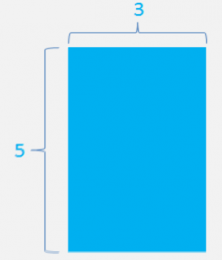In this post, we’re going to see what the commutative property is all about.
Example
Charles and George learned how to calculate the area of a rectangle in math class by using the base by height formula. Each of them was given a problem using the same rectangle, asking them to calculate the area.

Charles used the calculation below:
Area of rectangle = base x height = 5 x 3

His classmate, Oscar, used another:
Area of rectangle = base x height = 3 x 5

They didn’t finish multiplying yet, but they saw that they didn’t have the same set-up and they both wondered if they set up the problem correctly.
Which one do you think is on their way to correctly calculate the rectangle’s area?
If you guessed that both of them set up the problem correctly, good job. Both Charles and Oscar have set up the problem correctly. The only difference is their choice of base, 5 or 3.
Charles got 15 units for the rectangle’s area by calculating 5 x 3. Oscar also got 15 units, but he calculated 3 x 5.
We can see that regardless of how we calculate the area, 5 x 3 or 3 x 5, the answer doesn’t change because it’s the same rectangle turned on its side.
So then, the two classmates got the same correct answer of 15 units for the rectangle’s area.
Multiplication Table
One of multiplication’s properties is the commutative property. It states that the order of the factors doesn’t change the product. Our example got the same area by calculating 5 × 3 or 3 × 5; the answer doesn’t change.

Keep in mind that the commutative property is also relevant in addition. The order of an addition problem doesn’t matter, 4 + 8 or 8 + 4 is the same. You’ll get 12 in both cases.

I hope this post helped you understand this extremely important multiplication and addition property.
At Smartick, you have a ton of exercises where you can have a great time learning math, come on and give it a shot!
Learn More:
- Learn about the Distributive Property of Multiplication
- Distributive Property in Geometry
- Learn the Associative Property of Multiplication
- Calculating the Area of Polygons
- How to Perform Multiplication Problems with an Area Model







